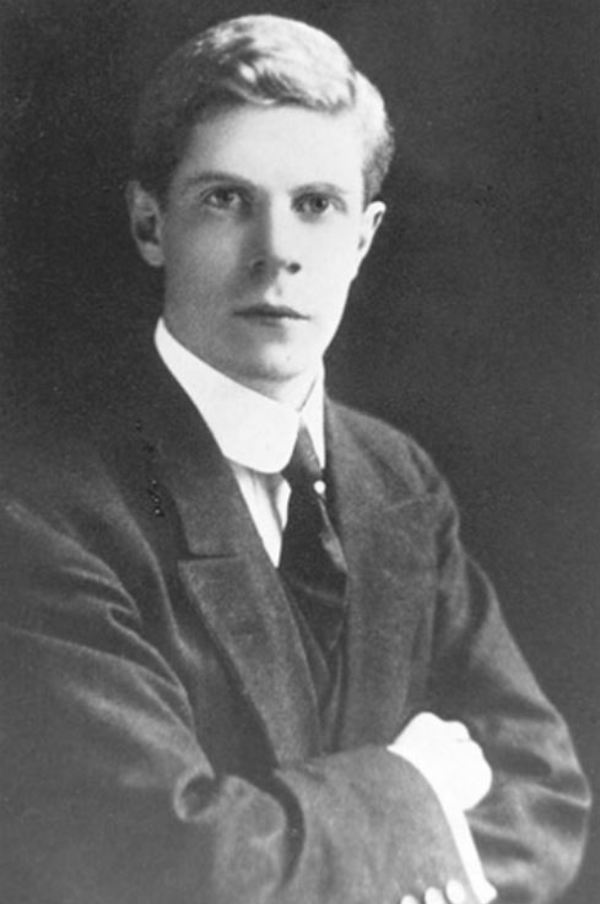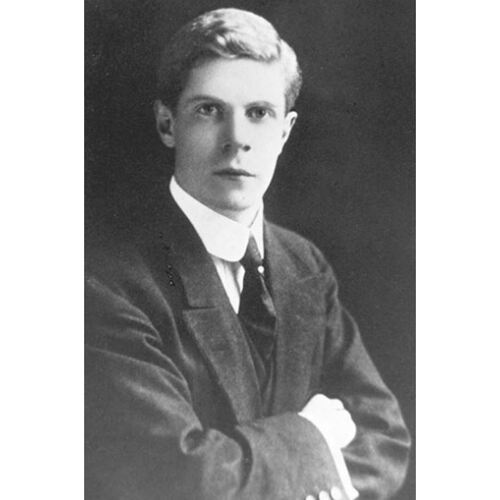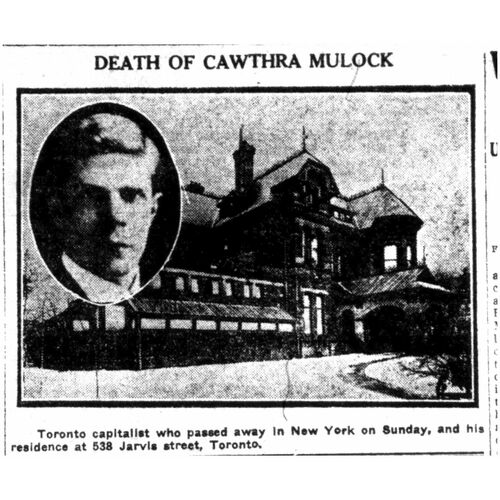
Source: Link
MULOCK, CAWTHRA, philanthropist and businessman; b. 17 May 1882 in Toronto, son of William Mulock* and Sarah Ellen Crowther; m. there 24 June 1903 Adèle Baldwin Falconbridge, and they had three daughters and a son; d. 1 Dec. 1918 in New York City and was buried in St James’ Cemetery, Toronto.
Cawthra Mulock was born to one of Toronto’s most eminent families. His father was a leading lawyer and mp; his mother’s aunt, Sarah Ellen Crowther, was the widow of William Cawthra* and William Allan Murray, both wealthy businessmen. Mulock was educated at Upper Canada College and at the University of Toronto, where his father was vice-chancellor and which he left after 1901, prior to graduating but with his future secured. In 1897 his great-aunt had died, leaving an estate of almost $2,700,000 to be administered by William Mulock. Most of it was bequeathed in trust to Cawthra – the press dubbed him “the boy millionaire” – with instalments to start at age 21. The residue, including Northwold, Sarah Cawthra Murray’s magnificent residence at Jarvis and Isabella streets, was to become his after he turned 25. Why his sisters and elder brother were passed over is a mystery.
Coincident with this inheritance, which vaulted Mulock into prominence in Toronto’s social and financial circles, his marriage in 1903 to a daughter of Chief Justice William Glenholme Falconbridge caused much consternation. Adèle was 19, a minor, and her family had evidently demanded that a trust first be established for her by Mulock. Moreover, she was Catholic and Mulock was Anglican. Catholic archbishop Denis O’Connor, intent on discouraging mixed marriages, insisted that they be wed in the priest’s residence rather than in a church or family home. Sir William Mulock, then a cabinet minister, enlisted pressure from Prime Minister Sir Wilfrid Laurier, apostolic delegate Donato Sbarretti y Tazza, and John Read Teefy, superior of St Michael’s College in Toronto, but O’Connor resisted and the marriage took place in the residence at Our Lady of Lourdes Church.
The following year Mulock was recruited for the board of Toronto General Hospital by its chairman, Joseph Wesley Flavelle*, apparently after someone close to Mulock, perhaps his father, suggested that he would be spoiled by his money unless he was put to work. Cawthra’s accompanying pledge of $100,000 was used to start a campaign for a new hospital, but his payments began only after he was threatened with court action. He sat as well on the board of the Toronto Guild of Civic Art and was a director of the National Horse Show Association. In 1907 he donated $10,000 to the Hospital for Sick Children.
Mulock is best known for building the Royal Alexandra Theatre in 1906–7 on King Street, west of Toronto’s theatre district. Determined to provide a modern centre for the performing arts, in 1905 he had formed a syndicate with Robert Alexander Smith, a broker and former president of the Toronto Stock Exchange, manufacturer Stephen Haas, and Lawrence Solman*, who owned a baseball team, an amusement park, and the Toronto Island ferries. Designed in the beaux-arts style by John MacIntosh Lyle* in association with Carrère and Hastings of New York, the theatre opened on 26 Aug. 1907. Its ornate interior and fireproof construction had contributed to substantial overruns, and the final cost was said to be double the original estimate. Although a theatre company was formed with Mulock as president, the “Royal Alex” was used largely by touring companies; in 1963 this Toronto landmark would be sold by Mulock’s estate to Edwin Mirvish and saved from demolition.
Wealth and a taste for entrepreneurship facilitated Mulock’s entry into business. In 1905 he had also led a syndicate that acquired a generating site at Eugenia, Ont., later sold to the Hydro-Electric Power Commission of Ontario. He bought a seat on the stock exchange in 1908 and was soon appointed to several boards. Apart from his wealth – he had received the remainder of his inheritance by 1909 – observers credited him with an eye for opportunity and the ability to ally himself with talented businessmen. He was a director of Confederation Life Association, the Imperial Bank of Canada, and the National Trust Company Limited. As vice-president of the Maple Leaf Milling Company Limited, he was responsible for the merger of bakeries in 1911 that formed the Canada Bread Company Limited, which he controlled. As well, he was president of the National Iron Works Limited and the Guardian Trust Company Limited and about 1912 he formed Cawthra Mulock and Company, bankers and brokers. His extensive real estate holdings also demonstrated his sound judgement. He developed lots in Toronto’s exclusive Rosedale district, for instance, and in 1909 he bought 26 acres of swamp land on Ashbridges Bay, where he built the plant of National Iron. In addition to the Cawthra home, where he lived, he owned waterfront and farm properties at Brighton Beach on Lake Simcoe. In 1913 the Toronto Daily Star, which estimated his worth at $4 million, reported him to be Toronto’s richest man after George Albertus Cox, Sir William Mackenzie*, John Craig Eaton*, and Sir Edmund Boyd Osler*.
Like his father, Mulock was a Liberal. A member of the general committee of the Ontario Liberal Association, he enjoyed good relations with Laurier, and he and his wife were occasional guests at the prime minister’s home. In 1911 Laurier asked him if he would stand as a candidate in Toronto Centre, but he refused.
Mulock died suddenly in 1918 while visiting New York, a casualty of the Spanish influenza epidemic. His estate, valued at $2,351,211.87, most of it in stocks and securities, was divided among his children. The $250,000 trust set up for his wife when they were married became the subject of extended litigation: efforts by the province to collect succession duties on the sum were ultimately dismissed by the Judicial Committee of the Privy Council. Adèle married her cousin Thomas Moss in 1919 and until her death in 1935 she divided her time between Toronto and a villa in Cannes, France.
Cawthra Mulock was an active clubman and a spirited and well-travelled socialite of good looks and fine manners. One of the most colourful of a new generation of Toronto capitalists, he was a canny investor in the city’s rising stock and real estate markets. The Royal Alexandra remains a monument to the imagination of its youthful builder and to the spirit of capitalism which allowed its construction and ensured its survival.
AO, RG 22-305, nos.12400, 37826; RG 80-5-0-309, no.2074. Archivio Segreto Vaticano (Rome), Delegazione apostolica del Canadà, 89.3. NA, MG 26, G: 139058–59, 139062, 188508–10; RG 31, C1, 1901, Toronto, Ward 3, div.35: 21 (mfm. at AO). St James’ Cemetery and Crematorium (Toronto), Burial records and tombstone, lot 14, sect.F hill. Daily Mail and Empire, 2 Dec. 1918. Evening Telegram (Toronto), 29 Sept. 1904; 9 Sept. 1919; 2 Jan., 19 June 1934. Globe, 30 Sept. 1904, 4 Dec. 1918, 3 Jan. 1935. Toronto Daily Star, 27 Aug. 1907, 4 Feb. 1913. World (Toronto), 22–24 Nov. 1897, 2 Dec. 1918. Attorney-General of Ontario v. Perry, [19331 Ontario Reports (Toronto): 218–24, 617–23; affirmed (1934), Law Times Reports (London), 151: 405–9. E. T. Bewley, The family of Mulock (Dublin, 1905). Michael Bliss, A Canadian millionaire: the life and business times of Sir Joseph Flavelle, bart., 1858–1939 (Toronto, 1978). Canadian annual rev. (Hopkins), 1905–6, 1909, 1913. Canadian men and women of the time (Morgan; 1912). I .M. Drummond et al., Progress without planning: the economic history of Ontario from confederation to the Second World War (Toronto, 1987). Robert Fairfield, “Theatres and performance halls,” in Early stages: theatre in Ontario, 1800–1914, ed. Ann Saddlemyer (Toronto, 1990), 228–32. N. J. Haynes, “A history of the Royal Alexandra Theatre, Toronto, Ontario, Canada, 1914–1918” (phd thesis, Univ. of Colo., Boulder, 1973). M. D. G. O’Neill, “A partial history of the Royal Alexandra Theatre, Toronto, Canada, 1907–1939”
Cite This Article
Alexander Reford, “MULOCK, CAWTHRA,” in Dictionary of Canadian Biography, vol. 14, University of Toronto/Université Laval, 2003–, accessed December 26, 2025, https://www.biographi.ca/en/bio/mulock_cawthra_14E.html.
The citation above shows the format for footnotes and endnotes according to the Chicago manual of style (16th edition). Information to be used in other citation formats:
| Permalink: | https://www.biographi.ca/en/bio/mulock_cawthra_14E.html |
| Author of Article: | Alexander Reford |
| Title of Article: | MULOCK, CAWTHRA |
| Publication Name: | Dictionary of Canadian Biography, vol. 14 |
| Publisher: | University of Toronto/Université Laval |
| Year of publication: | 1998 |
| Year of revision: | 1998 |
| Access Date: | December 26, 2025 |




